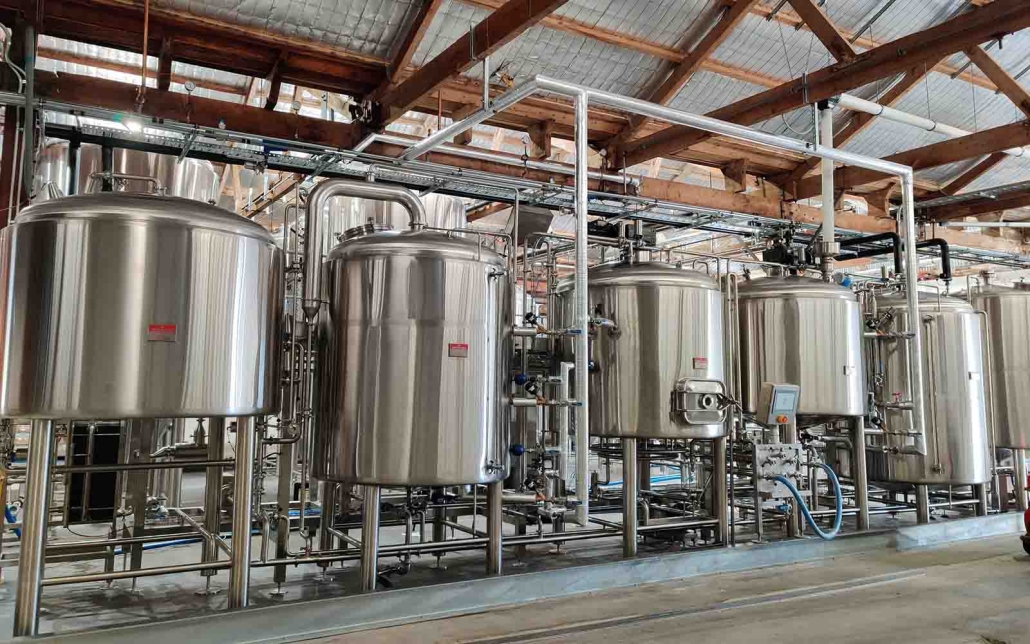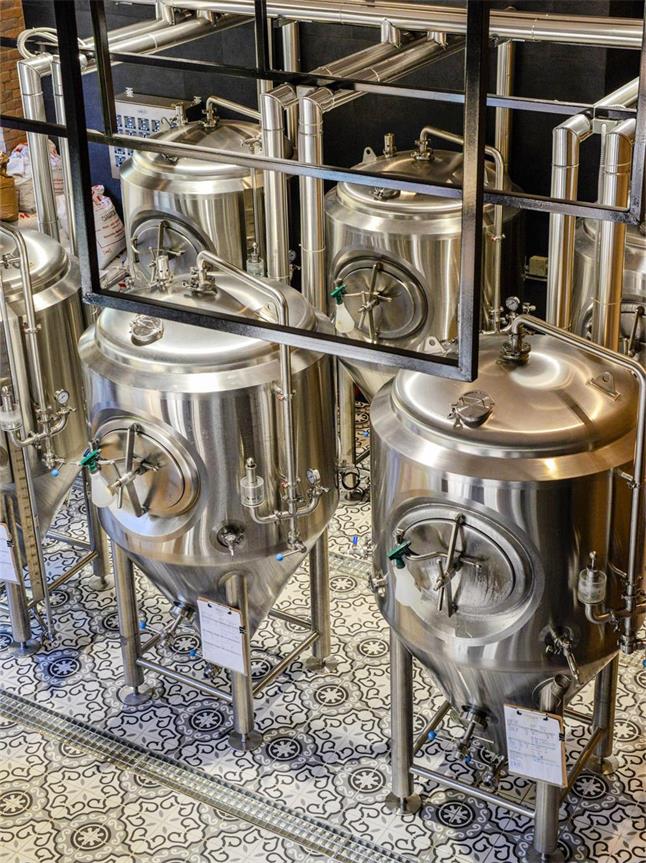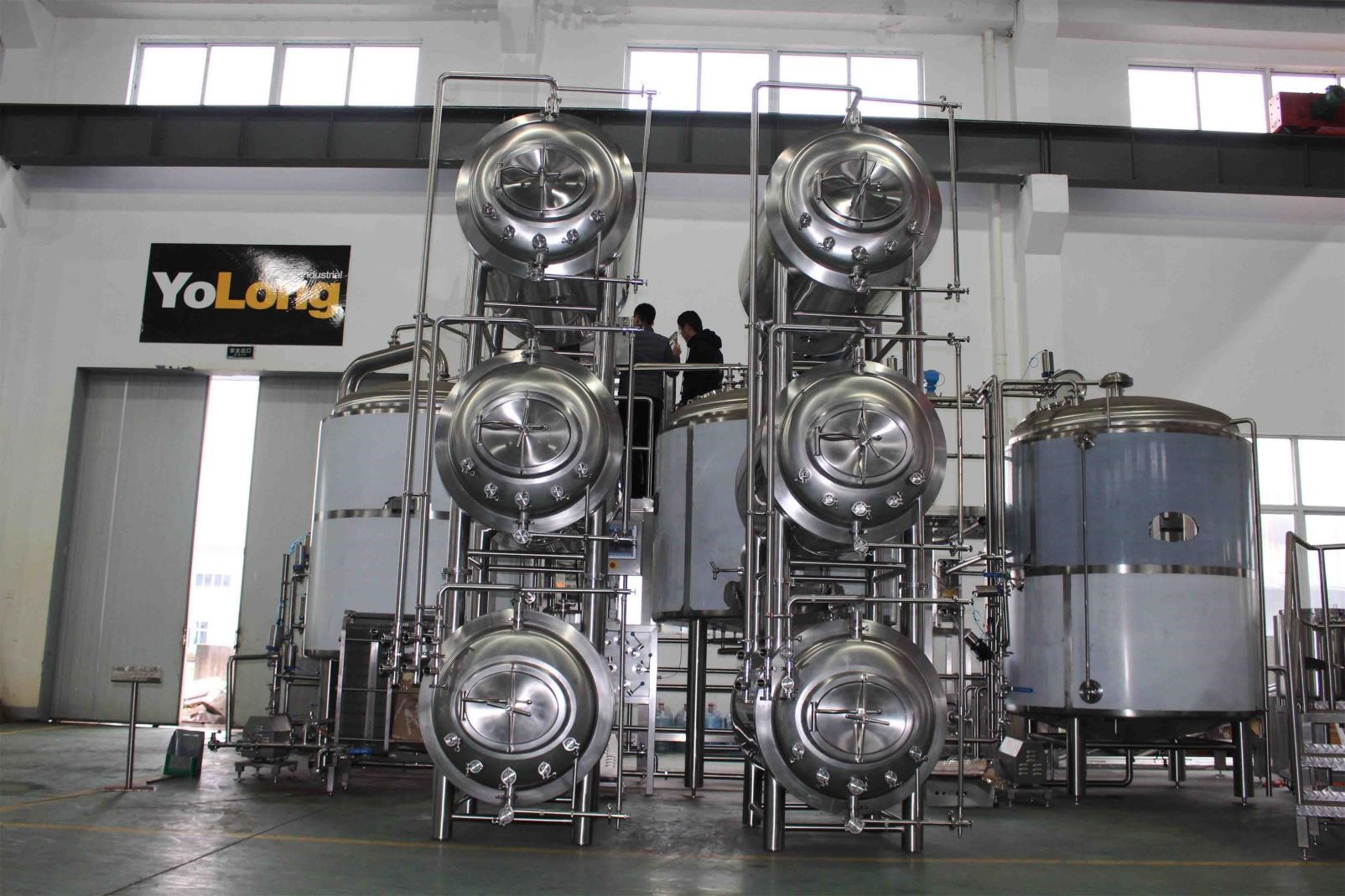Beer Fermentation Tanks
Beer fermentation tanks are essential equipment for proper beer production. This guide provides a comprehensive overview of beer fermentation tank types, sizes, layouts, suppliers, prices, and technical considerations for installation, operation, and maintenance.
Overview of Beer Fermentation Equipment
Beer fermentation is a critical step in brewing where yeast converts sugars into alcohol and carbon dioxide. Proper temperature control, agitation, and yeast health optimization during fermentation ensures high quality, consistent beer output.
Special fermentation tanks are used to provide optimum conditions for yeast activity. Key equipment pieces include:
Fermentation Vessels – Cylindroconical stainless steel tanks that hold beer during the fermentation process. Available in different diameter to height ratios. Fitted with cooling jackets, agitators, yeast collection systems and CIP sprayballs.
Temperature Control Systems – Cooling jackets around tanks use glycol/ammonia/freon systems to maintain steady fermentation temperature profile.
Yeast Propagation Systems – Special mini fermenters to grow sufficient healthy yeast for pitching into main fermentation tanks.
Yeast Storage Tanks – After fermentation, yeast sediment is collected and stored for reuse.
Carbonation Systems – Equipment for controlled injection of CO2 post-fermentation prior to bright beer tank storage.
Monitoring & Automation – Sensors, transmitters, process controllers are used to track temperature, density, pH and automate tank processes.
Proper fermentation tank configuration is critical for efficient beer production, quality and yield.

Beer Fermentation Tank Types
Many fermenter tank designs exist for different batch sizes, beer types and workflow formats. Main equipment configurations include:
| Tank Type | Description |
|---|---|
| Cylindroconical Tanks | Cone bottom tank with cylindrical upper section. Most common design with efficient yeast separation. Available from few BBLs to thousands of BBLs capacity. |
| Open Fermenters | Flat/sloped bottom, open top rectangular vessels. Allow easy access for fruit/ingredient addition. Limited to certain ale beer styles suited to ambient exposure. |
| Closed Fermenters | Cylindrical tanks with dish/conical bottom and closed top. Range from 5 to 30 BBLs. Used for ales and lagers. |
| Horizontal Fermenters | Cylindrical tanks placed in horizontal orientation. Require less vertical headroom. Up to 800 bbls. |
| Mixed Fermentation | Combination of vessel types for primary and secondary fermentation steps. Open tanks used for initial activity followed by closed tanks. |
Beer Fermentation Tank Sizes
Beer fermentation tanks cover a wide range of sizes from a few barrels to massive volumes over 1000 barrels. Some typical fermenter capacities include:
- Pilot Systems: 1-3 BBL
- Microbreweries: 3-7 BBL, 7-30 BBL
- Pub Breweries: 15-30 BBL
- Production Breweries: 30-300 BBL, 600-800 BBL, 1000+ BBL
Larger tanks have advantages of higher volume and less cleaning/handling per barrel but need substantial space and capital investment. Smaller tanks provide flexibility for more beer varieties.
Typical fermentation tank size selection considers:
- Annual beer production targets
- Peak seasonal production capacity
- Floorspace and height constraints
- Budget
With multiple fermenters, it is also important to have the right tank mixing – small and large units that can handle both flagship brews and experimental pilot batches.
Beer Fermentation Tank Designs
Fermenter tanks have different designs and accessory fittings tailored to facility requirements:
| Parameter | Options | Advantages | Limitations |
|---|---|---|---|
| Geometry | Cylindroconical <br> Horizontal Cylindrical <br> Open Top Rectangular | Efficient yeast settling <br> Height reduction <br> Accessibility | Tall height <br> Difficult CIP <br> Exposure risk |
| Construction | Stainless Steel <br> Aluminum <br> Plastic | Durable, impermeable <br> Cost-effective <br> Disposable | Cost <br> Reactive material <br> Single-use |
| Heating/Cooling | Cooling Jacket <br> Internal Cooling Coil <br> External Heating/Cooling | Uniform temperature <br> No contamination risk <br> Flexible applications | Complex install <br> Limited cooling <br> Hardware requirements |
| Agitation | Top-mounted mechanical <br> Side-mounted mechanical <br> Airlift pneumatic | Full mixing profile <br> Avoid top intrusions <br> No sealing requirements | Bearing maintenance <br> Shear effects <br> Weaker mixing |
| Yeast Handling | Conical bottom <br> External separator tank <br> Slope sheets | Compact design <br> Adjustable capacities <br> Easier cleaning | Height needs <br> Additional tank space <br> Leveling requirements |
Planning Beer Fermentation Tank Layout
Fermentation room layout balances production workflow, equipment spacing, service access and expansion flexibility:
- Linear layout places tanks in a single row
- Cluster layout groups tanks together with open workflows
- Compact layout fits more tanks by minimizing aisle space
- Modular layout has moveable racks and standardized spacing
- Multi-level layout uses second level mezzanines for small FVs
20% extra area should be allocated for tank maintenance access and yeast propagation systems. FV orientation relative to other equipment in brewhouse impacts slurry transfers, cleaning, forklift logistics etc.
Customization Options for Beer Fermentation Tanks
In addition to standard tank accessories like cooling jackets, agitators, CIP components etc., customizations enable unique capabilities:
Automatic yeast pitching – Density sensors trigger pumps for pitching at the right fermentation phase
In-tank dry hopping – Special tank bottom section for dry hop addition without opening the tank
Advanced automation – Touchscreen controllers, remote monitoring and data analytics integration
Hybrid uni/multivessel – Single FV switches between unitary and multivessel modes
Pressure/vacuum rating – Withstand high CO2 volumes or vacuum conditions for specialty processes
Steam jackets – Live steam injection for temperature boost or hot water sanitization
** canker**- Internal or external tank cladding for insulation benefits
Such custom features help enhance efficiency, reduce labour and enable novel processing techniques but add cost and complexity. Brewers should assess value proposition for bespoke designs versus off-the-shelf standard tanks on a case-by-case basis.
Beer Fermentation Tank Suppliers & Pricing
Many brewery equipment manufacturers supply fermentation tanks with sizes and configurations for all scales of production. A partial list includes:
| Supplier | Location | Price Range |
|---|---|---|
| JVNW | USA | $4,000 – $250,000 |
| Spike Brewing | USA | $6,500 – $100,000 |
| Ss Brewtech | USA | $7,500 – $150,000 |
| Premier Stainless | USA | $10,000 – $500,000 |
| Rolec Prozess | Germany | €5,000 – €300,000 |
| KEGGING | Italy | €7,000 – €150,000 |
Pricing varies based on material grade, volume, accessories and customizations ranging from $2,000 per BBL for basic mechanical tanks to over $10,000 per BBL for sophisticated automated FV systems.
Second-hand reconditioned tanks are also available at significant discount but have higher risk of defects and shorter remaining service lifespan. When requesting quotations, provide fermentation parameters, production targets, floorspace and layout constraints so vendors can appropriately size and configure tanks.
Installing and Operating Beer Fermentation Tanks
Proper fermenter installation, use and maintenance ensures optimal performance and longevity:
| Activity | Procedure | Frequency |
|---|---|---|
| Installation | Level tanks <br> Connect cooling lines <br> Wire control panels <br> Test sample batch | One-time |
| Cleaning | CIP with alkaline solution <br> Citric acid passivation <br> Hot water rinse | Each batch completion |
| Inspection | Check cooling jacket seals <br> Test sample valves <br> Inspect fittings/welds | Monthly |
| Maintenance | Replace aging cooling glycol <br> Rebuild agitator bearings <br> Inspect yeast dump valves | Yearly or per OEM specs |
Strict cleaning procedures between batches minimizes risk of contamination. Proactive inspections and preventative maintenance avoids unplanned downtime. Personnel must follow all standard safety protocols when working inside fermentation vessels.

Key Considerations for Selecting Beer Fermentation Tanks
Brewery Scale & Growth Plans
Match tank capacity and quantity to annual beer production targets. Factor in peak demand during seasonal spikes. Choose modular designs allowing incremental expansion without full system replacement.
Floor Plan Dimensions
Consider facility height, footprint and layout constraints. Measure doorway clearance, aisle width and overhead space to ensure tanks fit into building. Account for 20% extra space around tanks for operator movement and ancillary equipment.
Beer Variety Complexity
Simple lager portfolios need fewer larger fermenters while complex ales require more tanks with variable sizes for different recipes. Flexibility for short batch turnover around core brands allows innovation.
Budget Limitations
Weigh value of automation, exotic alloys and custom features versus basic functionality. Prioritize must-have accessories over nice-to-have upgrades given finite capex allocation.
In-House vs Turnkey Expertise
Evaluate ability to self-install tanks or outsource to specialists. Complex integrated systems with advanced automation may warrant vendor turnkey project. Simpler tanks can be DIY using modular designs and supplier support.
Future-Proofing Scope
Anticipate emerging beer trends, novel ingredients, and processing innovations that could require fermentation flexibility in 5-10 years. Choose designs accommodating projected needs via customization potential.
Regulatory Approvals
Get supplier support during certification process for welding standards, sanitary design, hazardous environment compliance etc. required by local food safety and alcohol bureaus.
Frequently Asked Questions (FAQ)
1) What working pressure should Beer Fermentation Tanks be rated for?
- For modern unitanks, target 1–2 bar (15–30 psi) MAWP with certified PRV/VacRV. This enables spunding, natural carbonation, and closed pressure transfers safely.
2) Jacketed vs. single‑wall: which is better for consistent fermentation?
- Jacketed stainless with glycol control and PID delivers tighter stability (±0.5–1.0 °F / ±0.3–0.6 °C) and faster crash cooling. Single‑wall tanks often require chambers or wraps and provide less precision.
3) How do I size glycol chilling for a cellar of Beer Fermentation Tanks?
- Plan ~1.5–2.0 refrigeration tons per actively fermenting 30 bbl FV during peak heat load; add 20–30% headroom and consider concurrency (e.g., simultaneous crashes). Consult OEM heat loss specs for your geometry and jacket area.
4) Which fittings/instrumentation add the most value on FVs?
- Tri‑clamp ports, sanitary sample valve, racking arm with position indicator, RTD in a thermowell, pressure transducer, carbonation stone with check valve, PRV/VacRV, and a CIP spray device sized to your pump.
5) How can I minimize oxygen pickup during dry hopping and transfers?
- Use purgeable hop‑dosers, CO2 purge tanks/hoses/BBTs, pressure‑transfer through purged lines, maintain gasket integrity and PRVs, and spot‑check DO at knockout and pre‑packaging where possible.
2025 Industry Trends for Beer Fermentation Tanks
- Oxygen‑aware cellars: closed dry‑hop dosing, pressure transfers, and inline/package DO checks are standardizing even in small breweries.
- Smarter telemetry: networked temp/pressure/SG sensors feed QC dashboards and traceability logs.
- Hygienic by design: shadowless manways, orbital welds, and validated spray coverage shorten CIP cycles and lower micro risk.
- Energy and water stewardship: better insulation, optimized jacket zoning, and CIP chemical optimization reduce utilities per hL.
- Modular scalability: retrofit kits for pressure capability, carb stones, level sensing, and jacket upgrades extend FV lifecycle.
2025 Benchmarks and Stats (Fermentation Tank Focus)
| Metric | Typical Range/Benchmark (2025) | Notes / Source |
|---|---|---|
| Working pressure (unitank) | 15–30 psi (1–2 bar) | OEM specs; PRV certification |
| Temp stability (jacketed + PID) | ±0.5–1.0 °F (±0.3–0.6 °C) | Multi‑zone jackets help |
| Crash time (68→32–34 °F) | 24–48 h for 20 bbl; 36–72 h for 60 bbl | Depends on chiller and ambient |
| Knockout DO (best practice) | <50 ppb (pro), <100 ppb (small) | ASBC/MBAA guidance |
| CIP cycle time (FV) | 30–60 min | Validated spray coverage/endpoints |
| Water-to-beer ratio (brewery) | 3.0–4.0 hL/hL; optimized ≤3.5 | Brewers Association Sustainability |
| Inline pressure transfer setpoint | 8–12 psi to BBT/keg | Prevents breakout/foaming |
Selected references:
- Brewers Association sustainability/technical resources: https://www.brewersassociation.org/industry/research
- American Society of Brewing Chemists (ASBC) Methods: https://www.asbcnet.org
- Master Brewers Association of the Americas (MBAA): https://www.mbaa.com
- EHEDG Hygienic Design Guidelines: https://www.ehedg.org
- U.S. DOE AMO tools (process heating, motors/VFDs): https://www.energy.gov/eere/amo/tools
Latest Research Cases
Case Study 1: Closed Dry‑Hop and Pressure Transfer Reduce DO in Beer Fermentation Tanks (2025)
Background: A regional craft brewery using 30–60 bbl unitanks reported elevated packaged DO and hop fade in hazy runs.
Solution: Implemented purgeable dry‑hop dosers, standardized CO2 purging of tanks/hoses, pressure transfers at 8–10 psi, and DO spot checks at knockout and pre‑packaging.
Results: Packaged DO decreased from 120–180 ppb to consistently 40–70 ppb; 45‑day sensory retained aroma intensity; returns for staling dropped by ~25%.
Case Study 2: Jacket Zoning + CIP Validation Improve Turn Time (2024)
Background: Inconsistent fermentation temps and long cleaning cycles on 40 bbl cylindroconicals.
Solution: Added cone+dual body jacket zones with independent valves and tuned PID; validated spray‑ball coverage, set conductivity/time endpoints for alkaline/acid cycles.
Results: Attenuation variance (SD) reduced ~30%; crash time improved ~20%; CIP cycle time reduced ~15% with lower chemical usage, increasing tank availability.
Expert Opinions
- Mary Pellettieri, Quality Consultant; Author of “Quality Management for Breweries”
“Measure what matters—calibrated temp probes, documented sanitizer concentrations, and DO checks at critical points. Reliable Beer Fermentation Tanks turn into reliable beer when validation is routine.” - John Mallett, Brewing & Quality Leader; Author of “Malt: A Practical Guide”
“Geometry and temperature control define fermentation outcomes. Multi‑zone jackets and gentle ramps protect yeast health and deliver repeatable flavor.” - Laura Ulrich, Senior Brewer and Industry Educator
“Design for cleanability and oxygen control—shadowless manways, purgeable ports, and dependable PRVs. These details pay off every single turn.”
Practical Tools/Resources
- ASBC Methods (DO, pH, VDK): https://www.asbcnet.org
- Brewers Association technical and sustainability guides: https://www.brewersassociation.org
- MBAA Technical Quarterly/webinars (cellar best practices, CIP validation): https://www.mbaa.com
- EHEDG hygienic tank/piping/CIP guidelines: https://www.ehedg.org
- DOE AMO calculators (insulation, pump/fan VFD savings): https://www.energy.gov/eere/amo/tools
- Brewfather or OrchestratedBeer/Beer30 for batch/QC logging: https://brewfather.app | https://www.orchestrated.beer | https://www.the5thingredient.com/beer30
SEO tip: Internally link “Beer Fermentation Tanks” to subpages on pressure fermentation and spunding, closed transfer and dry‑hop dosing, glycol system sizing, and CIP validation to deepen topical authority and guide buyers along the decision path.
Last updated: 2025-09-05
Changelog: Added 5 focused FAQs, 2025 trend benchmarks with table and sources, two recent case studies, expert viewpoints, and practical tools/resources tailored to Beer Fermentation Tanks.
Next review date & triggers: 2026-02-01 or earlier if BA/ASBC/EHEDG guidance updates, DOE benchmarks change, or vendor specs/lead times shift materially.
Share this entry
Interested in learning more about Brewing Systems including additional details and pricing information? Please use the form below to contact us!
YOLONG BREWERY EQUIPMENT FAQS
- Commercial Brewery / Craft Brewery / Microbrewery / Nanobrewery
- What is The Difference Between Craft Beer and Industrial Beer?
- The Bespoke Differences In Custom Brewing Systems
- Everything You Need to Know About Kettle Souring
- How to Choose Brewing Equipment for Your business?
- How To Choose The-Best Partner To Build Your Commercial Microbrewing System?
- Two Detection Sensors That You Need To Use In Your Brewhouse System
- Remote Control Applications in Brewing Equipment/How does it work?
- How To Clean Your Brand New Brewery Tanks?

